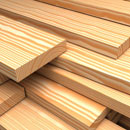Here's How: There Are Many Types and Grades of Lumber
Dear James: I went out to buy some lumber for some home projects. I was overwhelmed by the different kinds of lumber. What do the different grades and types of lumber mean? -- Bobbi T.
Dear Bobbi: Lumber is more than just a tree cut up into boards. There are many species of trees with different characteristics. Also, the methods in which the lumber is handled, treated and finished have a huge impact on which type is best for various applications and projects.
You will have to select among the various types of framing and finishing lumber. When selecting solid wood lumber for your project, you will find softwood and hardwood lumber from which to choose. Softwoods are from conifers, and hardwoods are from broadleaf deciduous trees. You will use mostly softwood lumber for your projects.
These terms refer to the species of the wood, not necessarily the hardness of the wood itself. Some softwood such as Douglas fir and yellow pine are actually harder than a hardwood such as poplar. Softwoods such as redwood and cedar resist insect damage. All types of pine take paint better than fir, and yellow pine is particularly strong for structural framing.
Hardwood lumber includes oak, cherry, maple, walnut, ash and beech. These woods are more expensive than the softwoods, and they are used primarily for furniture, fine cabinetry, paneling and flooring. You may use some of it for your finish work and decorative trim.
There are many grades (qualities) of softwoods to choose from, and their prices vary substantially. Softwoods are typically graded by their appearance, surface quality and strength. Thinner lumber, 1 inch thick and less, is graded by the characteristics of its best side, but make sure to check both sides for any serious flaws.
The appearance grading depends on the number of flaws in the lumber surface and its overall shape. The flaws include knots, stains, wormholes, checks, torn grain, wane (bark) and whether it is bowed, twisted or cupped. The best lumber with the fewest flaws is called select or finish lumber. This high-quality lumber has B, C, and D grades (descending order of quality) within it.
Most of the lumber that you will use on household repair and remodeling projects will be called "common." The grades within this group range from 1 (best) to 5 (worst). Grades 1 through 3 are still fairly good quality and will satisfy most of your needs.
If you need some higher-strength lumber for framing, blocking and plates, "light-framing" quality is a good choice. Grades within the group range from "construction" (highest quality) to "utility" (lowest quality). Where superior strength is needed, for rafters, trusses, etc., choose "structural light framing" lumber.
Hardwood lumber is graded differently than softwood lumber. Hardwoods are graded in the rough state before they are planed smooth, and the grade is based on the poorest quality side. The amount of clear wood (no flaws) is the determining factor. The grades in descending order of quality are "firsts," "seconds," "selects" and "common."
Most lumber mills belong to national trade associations, so you can be confident in the consistency of the grading. If you look carefully at a piece of lumber, you will find the grade stamp. It should show the trade association name, wood species, grade and moisture content of the wood when it was milled.
There are also two methods that mills use to cut the lumber from logs. Plainsawn lumber creates less waste at the mill, but quartersawn lumber is stronger and has straighter grain. Quartersawn lumber is more expensive than plainsawn lumber. You probably will not need any quartersawn hardwood unless you are doing natural trim work that is very noticeable.
========
Send your questions to Here's How, 6906 Royalgreen Dr., Cincinnati, Ohio, 45244 or visit www.dulley.com. To find out more about James Dulley and read features by other Creators Syndicate writers and cartoonists, visit the Creators Syndicate website at www.creators.com.
Copyright 2024 Creators Syndicate Inc.






























Comments